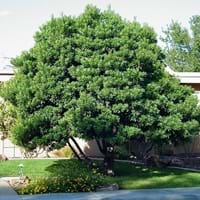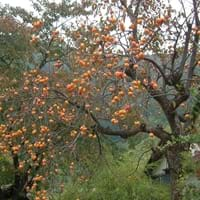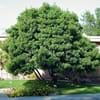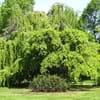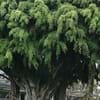Life Span
Perennial
Perennial
Origin
China, Japan
China, Korea
Types
it is a type of blueberry
Fuyu Persimmons
Hachiya Persimmons
Among(Ye mon)
Maru Persimmons
Habitat
Not Applicable
Woodlands
USDA Hardiness Zone
9-11
6-10
Sunset Zone
H1, 8, 9, 14, 15, 16, 17, 18, 19, 20, 21, 22, 23, 24
H1, 6, 7, 8, 9, 12, 14, 15, 16, 18, 19, 20, 21, 22, 23, 24
Habit
Upright/Erect
Pyramidal
Flower Color
White
Light Yellow
Flower Color Modifier
Bicolor
Bicolor
Fruit Color
Dark Blue, Black
Orange
Leaf Color in Spring
Green, Dark Green, Bronze, Orange Red
Green
Leaf Color in Summer
Dark Green
Green
Leaf Color in Fall
Dark Green
Yellow, Burgundy, Orange Red
Leaf Color in Winter
Red, Dark Green
Not Available
Leaf Shape
Crescent-shaped
Elliptic
Plant Season
Spring, Summer, Fall
Summer, Fall, Winter
Sunlight
Full Sun, Partial Sun
Full Sun, Partial Sun
Type of Soil
Loam, Sand
Clay, Loam
The pH of Soil
Acidic, Neutral
Acidic, Neutral
Soil Drainage
Average
Well drained
Bloom Time
Late Spring, Early Summer
Summer
Tolerances
Not Available
Not Available
Where to Plant?
Ground
Ground
How to Plant?
Rooted stem cutting, Seedlings
Seedlings
Plant Maintenance
Low
Medium
Watering Requirements
Requires watering in the growing season, Water when soil is dry
Do not water excessively, Do not water frequently, Prefer drip-irrigation instead of Over-head watering
In Summer
Lots of watering
Lots of watering
In Spring
Moderate
Moderate
In Winter
Ample Water
Average Water
Soil pH
Acidic, Neutral
Acidic, Neutral
Soil Type
Loam, Sand
Clay, Loam
Soil Drainage Capacity
Average
Well drained
Sun Exposure
Full Sun, Partial Sun
Full Sun, Partial Sun
Pruning
Prune in winter, Prune when young, Remove branches, Remove short twigs
Remove damaged leaves, Remove dead branches, Remove dead leaves
Fertilizers
All-Purpose Liquid Fertilizer, Fertilize in early spring, Mulch
All-Purpose Liquid Fertilizer, Apply N-P-K
Pests and Diseases
Black Silt, Leaf rust, Sooty Mold
Caterpillars, Mealybugs, Nematodes, Red blotch
Plant Tolerance
Not Available
Drought, Full Sun, Variety of soil types
Flowers
Showy
Insignificant
Flower Petal Number
Single
Single
Foliage Texture
Medium
Medium
Foliage Sheen
Glossy
Glossy
Self-Sowing
No
Not Available
Allergy
Not Available
Not Available
Aesthetic Uses
Bonsai, Showy Purposes
Bonsai
Beauty Benefits
For treating wrinkles, Skin Problems
Not Available
Environmental Uses
Air purification, Shadow Tree
Air purification
Medicinal Uses
Bone strength, Cancer, Diabetes, Digestion problems, Heart problems, High blood pressure, Improving mental health, Vitamin C, Weight loss
Anthelmintic, Antitussive, Antivinous, Appetizer, Astringent, Demulcent, Expectorant, Laxative
Part of Plant Used
Fruits
Fruits
Other Uses
Edible syrup, Employed in herbal medicine, Used As Food, Used as Ornamental plant
Cosmetics
Used As Indoor Plant
No
No
Used As Outdoor Plant
Yes
Yes
Garden Design
Hedges, Screening / Wind Break, Shade Trees, Street Trees
Edible, Fruit / Fruit Tree, Topiary / Bonsai / Espalier
Botanical Name
ELAEOCARPUS decipiens
DIOSPYROS kaki 'Hongsi'
Common Name
Japanese Blueberry
Asian Persimmon, Hongsi Persimmon, Japanese Persimmon, Kaki
In Hindi
जापानी ब्लूबेरी
Japanese Persimmon
In German
japanische Blaubeere
Japanese Persimmon
In French
bleuet japonais
Persimmon japonais
In Spanish
arándanos japonés
El caqui japonés
In Greek
ιαπωνική βατόμουρου
Ιαπωνικά Λωτός
In Portuguese
blueberry japonês
Persimmon japonês
In Polish
Japoński borówki
japoński Persimmon
In Latin
Vaccinium Italica
Persimmon Italica
Phylum
Not Available
Tracheophyta
Class
Not Available
Magnoliopsida
Order
Oxalidales
Ericales
Family
Elaeocarpaceae
Ebenaceae
Genus
Elaeocarpus
Diospyros
Clade
Angiosperms, Eudicots, Rosids
Angiosperms, Asterids, Eudicots
Tribe
Not Available
Not Available
Subfamily
Not Available
Not Available
Season and Care of Japanese Blueberry and Japanese Persimmon
Season and care of Japanese Blueberry and Japanese Persimmon is important to know. While considering everything about Japanese Blueberry and Japanese Persimmon Care, growing season is an essential factor. Japanese Blueberry season is Spring, Summer and Fall and Japanese Persimmon season is Spring, Summer and Fall. The type of soil for Japanese Blueberry is Loam, Sand and for Japanese Persimmon is Clay, Loam while the PH of soil for Japanese Blueberry is Acidic, Neutral and for Japanese Persimmon is Acidic, Neutral.
Japanese Blueberry and Japanese Persimmon Physical Information
Japanese Blueberry and Japanese Persimmon physical information is very important for comparison. Japanese Blueberry height is 910.00 cm and width 610.00 cm whereas Japanese Persimmon height is 760.00 cm and width 550.00 cm. The color specification of Japanese Blueberry and Japanese Persimmon are as follows:
Japanese Blueberry flower color: White
Japanese Blueberry leaf color: Green, Dark Green, Bronze and Orange Red
Japanese Persimmon flower color: Light Yellow
- Japanese Persimmon leaf color: Green
Care of Japanese Blueberry and Japanese Persimmon
Care of Japanese Blueberry and Japanese Persimmon include pruning, fertilizers, watering etc. Japanese Blueberry pruning is done Prune in winter, Prune when young, Remove branches and Remove short twigs and Japanese Persimmon pruning is done Remove damaged leaves, Remove dead branches and Remove dead leaves. In summer Japanese Blueberry needs Lots of watering and in winter, it needs Ample Water. Whereas, in summer Japanese Persimmon needs Lots of watering and in winter, it needs Average Water.
